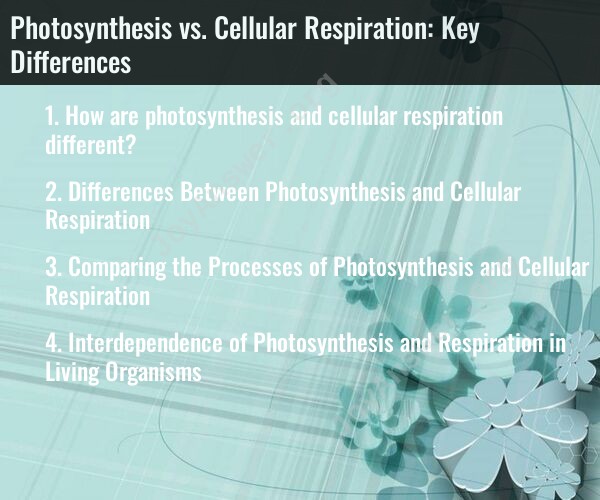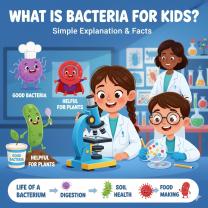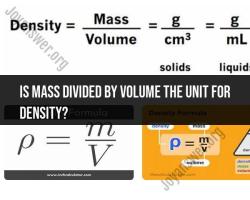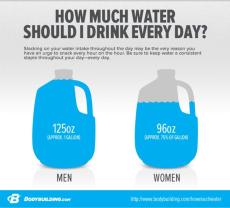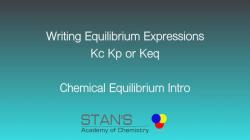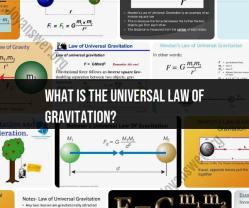How are photosynthesis and cellular respiration different?
Photosynthesis and cellular respiration are two fundamental biological processes that are related to each other and occur in different organelles of a cell. They have opposite functions and are crucial for the cycling of energy and matter in ecosystems. Here are the key differences between photosynthesis and cellular respiration:
Photosynthesis:
Location: Photosynthesis takes place in the chloroplasts of plant cells and in some types of bacteria (e.g., cyanobacteria).
Function: Photosynthesis is the process by which green plants, algae, and some bacteria convert light energy, typically from the sun, into chemical energy in the form of glucose (a sugar). This process is how plants produce their own food.
Inputs: The inputs for photosynthesis are carbon dioxide (CO2), water (H2O), and sunlight. Chlorophyll, a green pigment in chloroplasts, captures light energy.
Outputs: The outputs of photosynthesis are glucose (C6H12O6) and oxygen (O2). Glucose serves as an energy source for the plant, while oxygen is released into the atmosphere as a byproduct.
Overall Reaction: The overall chemical equation for photosynthesis is:
- 6 CO2 + 6 H2O + light energy → C6H12O6 + 6 O2
Cellular Respiration:
Location: Cellular respiration occurs in the mitochondria of eukaryotic cells (plants, animals, fungi) and in the cytoplasm of prokaryotic cells.
Function: Cellular respiration is the process by which cells break down glucose and other organic molecules to produce energy in the form of adenosine triphosphate (ATP). It is how cells obtain energy for their metabolic activities.
Inputs: The inputs for cellular respiration are glucose (or other organic molecules) and oxygen.
Outputs: The outputs of cellular respiration are carbon dioxide (CO2), water (H2O), and ATP. This process generates energy for cellular functions.
Overall Reaction: The overall chemical equation for cellular respiration is:
- C6H12O6 + 6 O2 → 6 CO2 + 6 H2O + ATP
Key Differences:
Purpose: Photosynthesis is an anabolic process that builds glucose from carbon dioxide and water using energy from light. Cellular respiration is a catabolic process that breaks down glucose to release energy.
Location: Photosynthesis occurs in chloroplasts, while cellular respiration occurs in mitochondria (and the cytoplasm in prokaryotes).
Inputs and Outputs: Photosynthesis takes in carbon dioxide and water, producing glucose and oxygen. Cellular respiration consumes glucose and oxygen, yielding carbon dioxide, water, and ATP.
Energy Transfer: In photosynthesis, light energy is converted into chemical energy (glucose). In cellular respiration, the chemical energy stored in glucose is converted into ATP, which is used for various cellular activities.
Relationship: These processes are interconnected in ecosystems. The oxygen produced in photosynthesis is used in cellular respiration, and the carbon dioxide produced in cellular respiration is used in photosynthesis. They are essential for the cycling of matter and energy on Earth.
Overall, photosynthesis and cellular respiration are complementary processes that are vital to life on Earth, providing energy for plants, animals, and other organisms in various ecosystems.
Differences Between Photosynthesis and Cellular Respiration
Photosynthesis and cellular respiration are two of the most important processes in the world. They are the opposite of each other, but they work together to create and sustain life.
Photosynthesis is the process by which plants use sunlight, water, and carbon dioxide to produce sugar and oxygen. Sugar is the food that plants need to grow and survive. Oxygen is a waste product of photosynthesis, but it is essential for animal life.Cellular respiration is the process by which cells break down sugar and oxygen to produce energy. Energy is the fuel that cells need to carry out their life processes.
Comparing the Processes of Photosynthesis and Cellular Respiration
The following table compares the processes of photosynthesis and cellular respiration:
| Process | Reactants | Products | Location |
|---|---|---|---|
| Photosynthesis | sunlight + carbon dioxide + water | sugar + oxygen | chloroplasts in plant cells |
| Cellular respiration | sugar + oxygen | carbon dioxide + water + energy | mitochondria in all cells |
As you can see, photosynthesis and cellular respiration are the opposite of each other in terms of their reactants and products. Photosynthesis uses sunlight, carbon dioxide, and water to produce sugar and oxygen. Cellular respiration uses sugar and oxygen to produce carbon dioxide, water, and energy.
Interdependence of Photosynthesis and Respiration in Living Organisms
Photosynthesis and cellular respiration are interdependent. Plants need the oxygen produced by cellular respiration in order to photosynthesize. Animals need the sugar produced by photosynthesis in order to carry out cellular respiration.
In short, photosynthesis and cellular respiration are two essential processes that work together to create and sustain life. Plants use photosynthesis to produce the sugar and oxygen that animals need to survive. Animals use cellular respiration to break down sugar and oxygen to produce the energy that they need to carry out their life processes.This process is known as the carbon cycle. The carbon cycle is the process by which carbon is recycled between the atmosphere, the oceans, and living organisms. Photosynthesis removes carbon dioxide from the atmosphere and stores it in plants. When plants die, the carbon dioxide is released back into the atmosphere through the process of decomposition. Animals eat plants and use the carbon dioxide in their bodies to produce energy. When animals die, the carbon dioxide is released back into the atmosphere through the process of decomposition.
The carbon cycle is essential for life on Earth. It ensures that there is always enough carbon dioxide in the atmosphere for plants to photosynthesize and enough oxygen in the atmosphere for animals to breathe.
